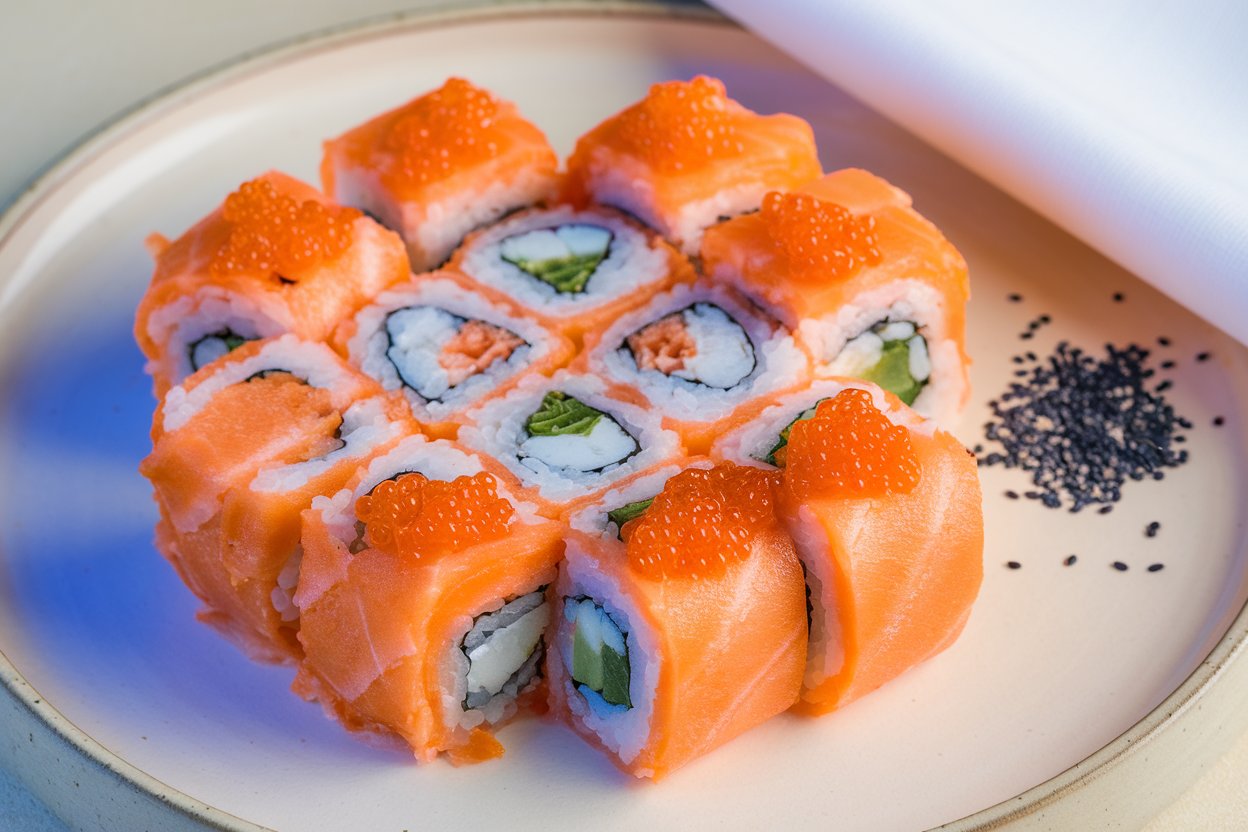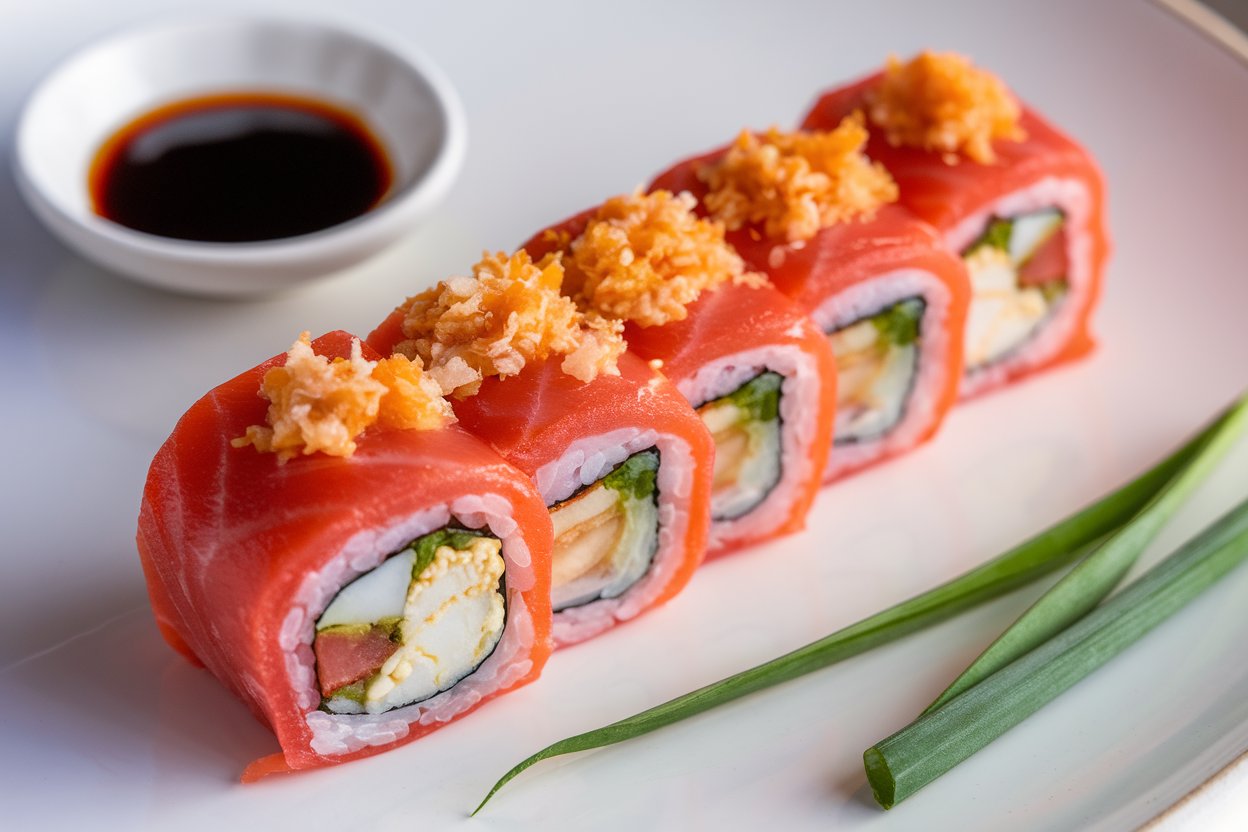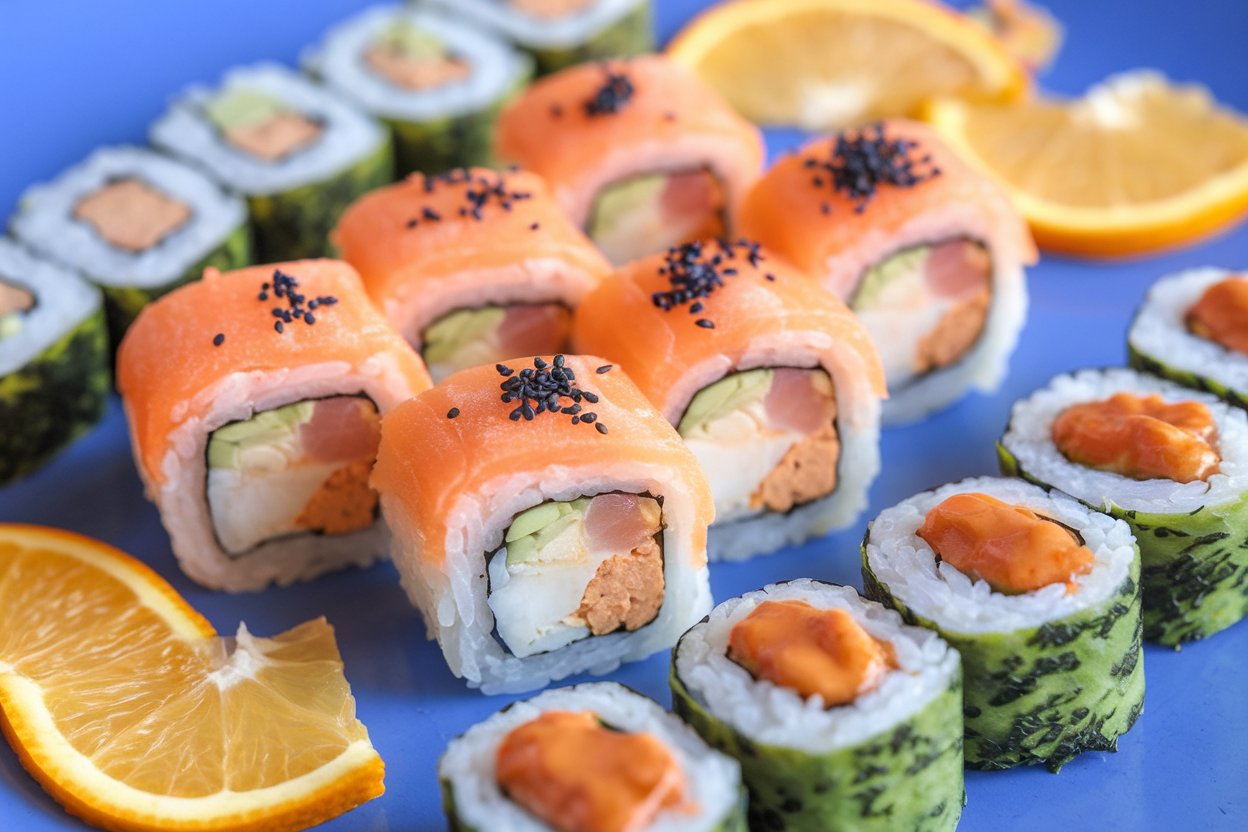When you think of sushi, what’s the first thing that comes to mind? Rice, seaweed, maybe even some wasabi? But let’s not forget the real showstopper – tobiko! These vibrant little pearls not only add a pop of color but also bring a unique crunch and a slightly smoky flavor to your favorite dishes. If you’re ready to dive into the world of tobiko, buckle up! We’re about to explore everything there is to know about this fascinating ingredient.
Table of Contents
What is Tobiko? An Introduction to the Iconic Sushi Topping
Tobiko is a type of fish roe – that’s right, fish eggs. Specifically, it comes from the flying fish, a species known for its ability to glide above water. Cool, huh? You’ll often see tobiko perched on top of sushi rolls, sprinkled over sashimi, or even used as a garnish on fancy dishes.
These tiny orange beads aren’t just about looks, though. They pack a delightful crunch and a burst of umami flavor that’s hard to forget. And trust me, once you’ve tried tobiko, it’s tough to go back.
The Origins of Tobiko: A Brief History
Ever wonder how tobiko became a sushi superstar? The tradition of using fish roe in Japanese cuisine dates back centuries, with tobiko gaining popularity in the mid-20th century as sushi culture spread worldwide. Its vibrant color and versatility made it an instant favorite among chefs and foodies alike. Nowadays, you’ll find tobiko not only in Japanese restaurants but also in fusion dishes around the globe.
Tobiko vs. Other Roe: What Sets It Apart?
Sure, there are plenty of other fish roes out there – caviar, ikura, masago – but tobiko stands out for a reason. Unlike caviar’s luxurious, buttery texture or ikura’s larger, softer pearls, tobiko is small, crunchy, and slightly sweet. Think of it as the fun cousin of the fish roe family, bringing texture and excitement to every bite.
The Culinary Significance of Tobiko
Why do chefs and home cooks adore tobiko? It’s all about versatility. Whether you’re whipping up traditional Japanese dishes or experimenting with modern recipes, tobiko adds that “wow” factor. Plus, its vibrant colors make any plate Instagram-worthy. 📸✨
Why Tobiko is Popular in Japanese Cuisine
In Japanese cuisine, tobiko is more than just a garnish – it’s a star ingredient. Its smoky-salty flavor complements rice, seafood, and even eggs. Whether it’s topping a California roll or scattered over a chirashi bowl, tobiko elevates even the simplest dishes.
Tobiko in International Cuisine: Fusion and Beyond
Tobiko isn’t just for sushi anymore. Chefs around the world are using it in creative ways, from pasta dishes to canapés. Imagine a creamy avocado toast sprinkled with tobiko – sounds fancy, right? Its adaptability makes it a favorite for culinary experimentation.
Types and Colors of Tobiko
You’ve probably seen the classic orange tobiko, but did you know it comes in other colors too? Each hue brings its own unique twist to the table.
Traditional Orange Tobiko

The OG of tobiko, orange tobiko is the most common type you’ll find. It has a mild, smoky flavor that pairs well with just about anything. It’s like the vanilla ice cream of fish roe – classic and versatile.
Wasabi Tobiko: A Spicy Twist
If you like a little heat, wasabi tobiko is your go-to. Infused with spicy wasabi, these green pearls pack a punch without being overpowering. Think of it as the sushi equivalent of hot sauce. 🌶️
Black Tobiko: The Elegant Choice
Black tobiko is like the little black dress of fish roe – sleek, elegant, and perfect for special occasions. Its flavor is slightly richer and smokier, making it a sophisticated choice for upscale dishes.
Red Tobiko: A Vibrant Variation

If you want to add a bold pop of color to your plate, red tobiko is where it’s at. It’s slightly spicier than the orange variety and often used to make dishes visually stunning.
Nutritional Value
Is tobiko healthy? You bet it is! Despite its indulgent reputation, tobiko is packed with nutrients that can actually be good for you. 🥗
Is Tobiko Healthy? A Nutrient Breakdown
Here’s a quick look at what makes tobiko a surprisingly nutritious choice:
| Nutrient | Per 1 Ounce (28g) |
|---|---|
| Calories | 40 |
| Protein | 4g |
| Fat | 1g |
| Omega-3 Fatty Acids | 100mg |
| Vitamin B12 | 4.5mcg (75% DV) |
| Selenium | 18mcg (32% DV) |
Tobiko is low in calories and fat, high in protein, and a great source of omega-3 fatty acids. It’s also rich in vitamin B12, which is essential for energy production and brain health.
“Tobiko isn’t just tasty – it’s a tiny powerhouse of nutrients.”
Tobiko and Dietary Considerations: Gluten-Free, Keto, and More
Got dietary restrictions? No worries! Tobiko is naturally gluten-free, keto-friendly, and low-carb. However, some brands may add artificial coloring or flavoring, so it’s always a good idea to check the label.
Common Uses in Cooking
Tobiko is a culinary chameleon, fitting seamlessly into a variety of dishes. Let’s explore some popular uses.
Tobiko in Sushi: Nigiri, Maki, and Sashimi
Whether it’s topping a piece of nigiri, rolled into a maki, or sprinkled over sashimi, tobiko is a sushi staple. Its crunchy texture and salty-sweet flavor make it the perfect finishing touch.
Creative Recipes with Tobiko: Beyond Sushi
Why stop at sushi? Tobiko can jazz up everything from omelets to pasta dishes. Try mixing it into a creamy seafood risotto or using it as a topping for deviled eggs. Your taste buds will thank you. 😋
Garnishing with Tobiko: Elevating Presentation and Flavor
Let’s be honest – food is as much about looks as it is about taste. Tobiko’s vibrant colors can turn even the most basic dish into a work of art. Sprinkle it over a salad or soup for an instant upgrade.
Common Problems
While tobiko is undoubtedly delicious and versatile, some common concerns and questions arise when it comes to consuming and storing these little pearls. Let’s address these to help you enjoy your tobiko experience worry-free.
Is Tobiko Safe to Eat? Addressing Health Concerns
For the most part, tobiko is perfectly safe to eat. However, it’s always wise to consume it in moderation, especially if you’re watching your sodium intake. Tobiko is naturally salty, and some brands even add extra salt during processing. If you have high blood pressure or are on a low-sodium diet, keep an eye on your portions.
Another consideration is the potential for contamination. Like any seafood product, tobiko should be sourced from a reputable supplier to avoid any risk of foodborne illness. When in doubt, trust your senses – fresh tobiko will have a clean, briny aroma, not a fishy or sour smell.
“When it comes to seafood, freshness is king. If it doesn’t smell right, don’t eat it!”
Allergies and Tobiko: What You Need to Know
If you have a seafood allergy, it’s best to steer clear of tobiko. Fish roe can trigger allergic reactions in sensitive individuals, so always check with a doctor if you’re unsure. Some tobiko products may also contain added ingredients like soy or artificial coloring, which can be allergens for some people.
How to Store Tobiko Properly to Avoid Spoilage
Tobiko doesn’t last forever, but with proper storage, you can extend its shelf life. Always refrigerate tobiko in an airtight container to maintain its freshness. If unopened, it can last in the fridge for up to two weeks. Once opened, aim to use it within 3–5 days.
Freezing is another option if you’re not planning to use tobiko immediately. It freezes well and can be stored for up to three months. Just be sure to thaw it slowly in the refrigerator to maintain its texture and flavor.
How to Choose High-Quality Tobiko
Shopping for tobiko can be a bit tricky, especially if you’re not sure what to look for. Let’s break it down so you can pick the best quality every time. 🛒
Tips for Buying Tobiko at the Market
When buying tobiko, always go for bright, vibrant colors and a firm texture. Avoid anything that looks dull or mushy – that’s a sign it’s past its prime. If possible, give it a sniff. Fresh tobiko should smell clean and briny, like the ocean.
Pro Tip: “If you’re buying packaged tobiko, check the expiration date and opt for a brand that uses minimal additives.”
Recognizing Fresh vs. Imitation Tobiko
Not all tobiko is created equal. Some cheaper options on the market are actually imitation tobiko made from flavored gelatin. While these can look convincing, they lack the authentic crunch and flavor of the real deal. Always read the label and, if possible, buy from a trusted seafood market.
Pairing Tobiko with Other Ingredients
Tobiko isn’t just a standalone ingredient – it shines when paired with complementary flavors. Let’s explore some delicious combinations that will make your dishes unforgettable.
Best Sushi Pairings with Tobiko
When it comes to sushi, tobiko pairs beautifully with creamy and mildly flavored ingredients. Think avocado, cucumber, or crab meat. These ingredients balance out tobiko’s saltiness while letting its unique flavor shine.
For an elevated experience, try tobiko with uni (sea urchin) or fresh salmon. These luxurious ingredients enhance the richness of the dish and create a burst of flavors in every bite.
Beverage Pairings:
What’s the perfect drink to enjoy with tobiko? For sushi, sake is the obvious choice. Its subtle sweetness and smooth finish complement the salty crunch of tobiko. Prefer something non-alcoholic? Green tea works wonders too. Its earthy notes cleanse your palate, letting you fully enjoy each bite.
If you’re feeling adventurous, try pairing tobiko dishes with sparkling wine or champagne. The bubbles cut through the richness of seafood and make the experience extra celebratory. 🥂
Tobiko’s Role in Food Trends and Culture
Let’s be real – tobiko isn’t just food; it’s a vibe. Whether it’s gracing a sushi roll or making an appearance in a fancy fusion dish, tobiko has a way of turning heads.
Tobiko in Modern Gastronomy
Chefs worldwide are pushing the boundaries of what tobiko can do. From tobiko-infused aioli to tobiko-topped steak tartare, this ingredient is showing up in unexpected places. Its versatility makes it a favorite among experimental chefs looking to add a touch of luxury and fun to their menus.
The Role of Tobiko in Food Aesthetics and Social Media
Let’s not forget the power of presentation. Tobiko’s vibrant colors make it a star on Instagram and food blogs. A dish sprinkled with tobiko instantly looks more gourmet, and let’s be honest, we eat with our eyes first. 📸✨
Whether it’s a perfectly crafted sushi roll or a bold fusion dish, tobiko has become a symbol of modern culinary creativity. And with food trends leaning heavily toward visual appeal, we can expect to see even more of this tiny superstar in the future.
Conclusion:
So, there you have it – everything you need to know about tobiko, the tiny pearls of joy that pack a big punch. Whether you’re a sushi lover, a home cook, or just someone who appreciates good food, tobiko has something to offer. It’s versatile, nutritious, and oh-so-delicious.
The next time you’re enjoying a sushi roll or experimenting in the kitchen, don’t forget to add a sprinkle of tobiko. Trust me, it’s the little details that make all the difference. 🎉
FAQ :
Is tobiko actually fish eggs?
Yes, tobiko is indeed fish eggs! 🐟 Specifically, it is the roe of flying fish, which are known for their unique ability to leap above the ocean waves. These tiny eggs are harvested and cured to enhance their flavor and are commonly used in sushi and other Japanese dishes.
What is tobiko?
Tobiko is the roe (eggs) of flying fish. It’s famous for its bright orange color, crunchy texture, and slightly sweet, salty taste. Tobiko is often used as a topping on sushi rolls, sashimi, or even fusion dishes like tobiko pasta. It’s also sometimes dyed in vibrant colors like black, green (wasabi-flavored), or even red to enhance its visual appeal.
Does tobiko taste like caviar?
While tobiko and caviar are both types of fish roe, their flavors are quite different. Tobiko has a mild, slightly sweet flavor with a delicate crunch, while caviar (typically from sturgeon) is much saltier, creamier, and richer. Think of tobiko as playful and light, while caviar is more sophisticated and bold.
What is the difference between tobiko and ikura?
The main differences between tobiko and ikura lie in their size, texture, and flavor:
- Tobiko: Smaller eggs, crunchy texture, mild and sweet flavor. 🧡
- Ikura: Larger eggs, soft and juicy texture, bold and salty flavor. 🧡
Tobiko is often used for its aesthetic and texture in sushi rolls, while ikura is considered more luxurious and is served in traditional dishes like ikuradon (salmon roe rice bowl). Both are delicious but serve different culinary purposes! 🍣

